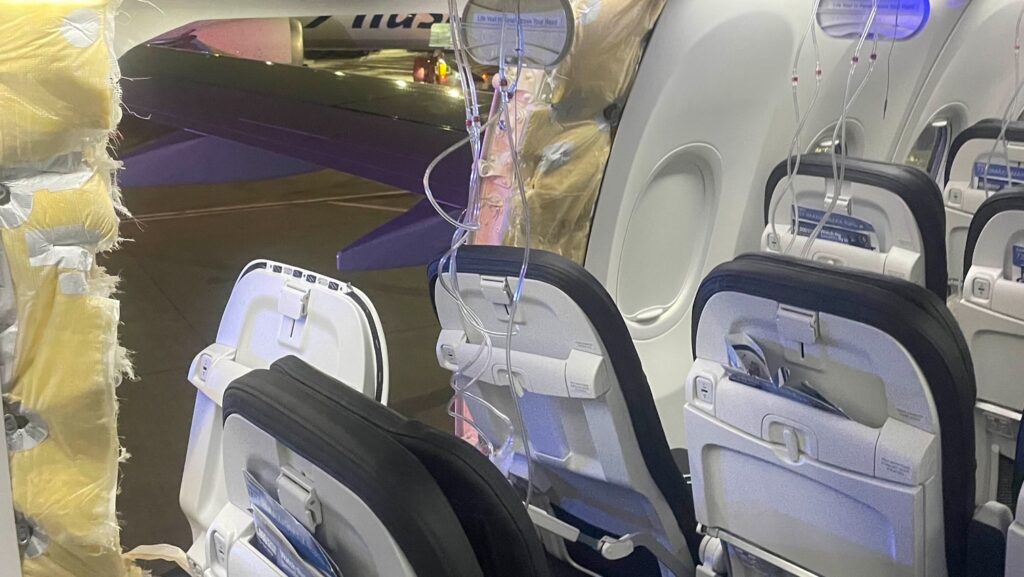Max 9 News Release

SEATTLE, WA. – Today attorney Mark Lindquist filed an amended lawsuit against Boeing and Alaska Airlines on behalf of 22 passengers on Alaska Airlines Flight 1282.
A nearly new Boeing 737 Max 9 plane was flying from Portland, Oregon to California on January 5. At 16,000 feet, there was a loud bang and whoosh as a door plug blew out of the fuselage and the plane immediately depressurized.
Lindquist initially filed a lawsuit on January 16 alleging emotional and physical injuries to passengers, including severe stress, anxiety, trauma, and hearing damage. The Amended Complaint adds new passengers and new allegations of negligence by Boeing and Alaska Airlines.
New Evidence
New allegations include a claim, “there was a whistling sound coming from the vicinity of the door plug on a previous flight of the subject plane. Passengers apparently noticed the whistling sound and brought it to the attention of flight attendants who reportedly informed the pilot or first officer.”
No known further action was taken, “After the pilot checked cockpit instruments, which purportedly read normal.”
Additionally, Lindquist cites the recent National Transportation Safety Board (NTSB) preliminary report, which found the cockpit door was designed to blow out in a depressurization situation. Pilots and crew were not informed of this design feature.
“The resulting shock, noise, and communication difficulties contributed to a lack of proper communication between the flight crew and passengers, thereby intensifying confusion and stress,” according to the lawsuit.
Aviation Attorney
Lindquist, who represented dozens of victim families in the two fatal crashes of the Boeing 737 Max 8 in 2018 and 2019, said Boeing should have fixed their quality control issues after 346 people died in the Max 8 crashes.
“Boeing is still cutting corners on quality,” Lindquist said. “The company is cutting so many corners, they’re going in circles.”
The NTSB report found Boeing delivered the plane to Alaska Airlines with four retaining bolts missing, which resulted in the eventual door plug blowout.
“This plane was a ticking bomb,” Lindquist said. “A blowout could have happened at a cruising altitude where it would have been catastrophic.”
Among the 22 listed plaintiffs in the lawsuit are a couple with an infant, a mother and her 13-year-old daughter, and an unaccompanied minor.
Lindquist filed the first lawsuit against Alaska Airlines in this incident. Other law firms are expected to follow suit.
Boeing Max 9
The nearly new 737 Max 9 plane was put into service on October 31 of this year, Halloween.
“Boeing delivered a plane with a faulty door plug that blew out of the fuselage at 16,000 feet and air masks that apparently did not function properly,” the lawsuit states.
“Plaintiffs feared the gaping hole in the fuselage, rapid depressurization, and general havoc was a prelude to the plane’s destruction and their own likely death.”
According to Lindquist, “Some passengers were sending what they thought would be their final text messages.”
One plaintiff wrote, “Dude, something just blew up on the plane.“
Another plaintiff wrote, “Mom our plane depressed. We’re in masks. I love you.”
Alaska Airlines
Under Washington Law, Alaska Airlines, as a common carrier, “has a duty to its passengers to exercise the highest degree of care.” And “any failure of a common carrier to exercise such care is negligence.”
Though the plane was only two-months-old, there had been prior incidents of depressurization warning lights going off. While there does not yet appear to be a direct link between prior issues of depressurization warning lights and the blowout, management pulled the plane from routes over open water.
“Alaska Airlines management decided the subject plane was not safe to fly over the ocean, but was somehow safe enough to fly over land,” the lawsuit states. “This risky decision endangered passengers.”
Lindquist added, “There’s no reasonable way for an airline executive to explain to the jury how they thought the plane was not safe to fly over the ocean but was safe to fly over land.”
At the time of the blowout, the plane was still climbing, nobody was seated directly next to the door plug, and passengers were still wearing their seatbelts.
“Blind luck that nobody died,” Lindquist said.
Terror continued on the plane for several minutes. Passengers did not know if the plane could continue to fly while depressurized with a gaping hole in the fuselage.
Eventually, the plane completed a successful emergency landing at the Portland airport. Some passengers accepted other flights to their destination. Some declined.
Lawsuit Allegations
Lindquist charges three counts: one count of Negligence against both Boeing, one count of Strict Product Liability against Boeing under Washinton’s Product Liability Act, and one count of Negligence against Alaska Airlines.
The Federal Aviation Administration (“FAA”) and the NTSB are investigating the incident and surrounding circumstances, including Boeing’s quality control programs.
“It took the FAA three months and a second crash to ground the Max 8,” Lindquist said, “so it’s good to see quick action from the FAA on the Max 9. Boeing has proved it can’t be trusted as its own watch dog.”
In addition to civil litigation by Lindquist and other aviation attorneys around the country after the Max 8 crashes, Boeing faced criminal charges by the Department of Justice. Boeing’s C.E.O. was replaced in the storm of negative publicity.
A few days after the Max 9 incident, the new Boeing CEO referred to the blowout as a “quality escape,” which Lindquist cites in the lawsuit. The CEO explained “quality escape” was “anything that could potentially lead to an accident.” The lawsuit alleges the CEO admitted “a mistake” by Boeing.
In the Max 8 disasters, Boeing initially denied responsibility. “It’s encouraging to see the CEO step up this time and recognize the importance of accountability,” Lindquist said. “Though it’s too soon to know for sure what exactly went wrong, we know Boeing is ultimately responsible for the safety of their planes and Alaska Airlines is ultimately responsible for the safety of their passengers.”
On January 12, the Alaska Airlines CEO sent an email to passengers, “I am writing to personally apologize for what you experienced on Friday night. Several of you have shared how you are grappling with what happened. This was a scary experience and I’m so sorry you went through it.”
Lindquist said, “My clients want accountability for Boeing and Alaska Airlines. They also want assurances that this isn’t going to happen again to anyone.”
Individual Passengers
More individual lawsuits are expected by additional passengers. Mark Lindquist Law is still accepting clients in the Max 8 calamity and currently represents thirty passengers.
“While all the passengers have some things in common, their injuries are different based on where they were seated, their individual reactions, and how they are faring,” Lindquist said. “Each passenger is an individual with individual interests.”
Lindquist’s firm focuses on personalized support and attention for clients.
Attorney Lindquist
In addition to successfully representing dozens of victim families in the lawsuits following the Max 8 crashes, Lindquist has represented passengers who survived small plane crashes. His firm often represents victims of corporate or government negligence and misconduct.
Before entering private practice as a personal injury lawyer, Lindquist was the elected District Attorney in Pierce County, Washington, for nearly a decade. As the Tacoma Weekly wrote, “he won a reputation for supporting crime victims and holding defendants accountable.”
He successfully prosecuted some of the most high-profile cases in the state, including the murder and rape of a Special Olympian, the murder of a Tacoma cab driver, and the Tacoma Mall Shooting.
Lindquist is also a regular legal and trial commentator for local and national media. Mark Lindquist Law is in Tacoma, WA.
Update: Mark Lindquist Law currently represents 35 passengers from Alaska Flight 1282 and is still accepting clients.
